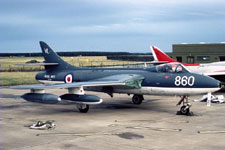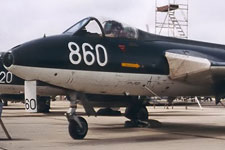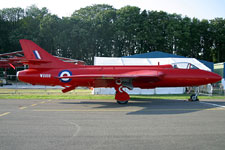| XF300's service history
XF300 was built as a Hunter F.4 for the Royal Air Force by Hawker Aviation (Blackpool) Ltd. at its Lancashire factory. Following the necessary flight tests, the aeroplane was accepted by the RAF on 9th January 1956 at 5MU (Maintenance Unit) Kemble, where it was subsequently prepared for entry into service. Its first Squadron posting was to RAF 234(F) Sqn based at RAF Geilenkirchen in West Germany as aeroplane 'P', and it was later moved to RAF Bruggen where it became 'W' of RAF 130(F) Sqn.
During 1960, XF300 was bought back to the UK and placed in store.
Transferred to the Royal Navy, XF300 was converted to GA.11 specification by Hawker Aircraft under contract, and was delivered to the Fleet Air Arm at RNAS Lossiemouth on 12th February 1963. Prepared for Squadron service by the Aircraft Holding Unit (AHU), the aeroplane was assigned to 738NAS (Navy Air Squadron) as Lossiemouth and assigned the fleet number '643' and shore code 'LM' on the tail-fin. A move with the Squadron followed in December 1963 to RNAS Brawdy, where the aeroplane continued in service aside from modernisation at RNAY Belfast (September-October 1964) until January 1968, ending its time with the Unit as aeroplane '783'.
A move back to RNAS Lossiemouth and a transfer to 764NAS followed, and XF300 was given the fleet identity '694'. Its early life with the Unit was not without incident, as it was involved in an incident that resulted in fellow GA.11 WT744 sustaining damage. Following a period of modernisation at 5MU (maintenance Unit) at Kemble between May 1970 and October 1971, XF300 became aeroplane '690' at Lossiemouth, and remained in service until it was moved back to Kemble for long term storage/modernisation on 18th July 1972.
On 26th March 1980, XF300 arrived at RNAS Yeovilton to join the Fleet Requirements and Air Direction Unit (FRADU) fleet, and was assigned the unallocated fleet number '860'. It received a re-finish between June and July 1981, and suffered Cat.3 damage following a serious bird-strike at RAF Kinloss in Scotland on 7th March 1984. The airframe was repaired on site and was able to return to Yeovilton by air on 6th June 1984, but within six months the aeroplane was sent to Lovaux Ltd. at Hurn for a full overhaul.
On 6th June 1986 XF300, now sporting the new standard dark sea grey finish returned to the fleet and remained active with FRADU, aside from a overhaul at Hurn (April 1993-January 1994), until its final retirement in 1995. It was ferried to RAF Shawbury for storage on 12th June that year. |

[© unknown]

[© Richard Parkhurst]

[© Ed Groenendijk]
|
XF300's civilian life
XF300 was entered into the July 1995 Philips auction, but it was withdrawn from sale due to complications with its ownership having received United States funding when it was manufactured. This issue was finally resolved in 2000, and it was entered into the MoD aircraft auction held at Phillips in London during November.
Sold to Barry Pearson, XF300 was placed on the civilian register as G-BZPC and it left Shawbury on 14th February 2001 bound for the Classic Jet Aircraft Company at Exeter Airport. The aeroplane was re-finished later that year to represent Hunter F.3 WB188, in preparation for the 50th anniversary of Neville's Duke's successful airspeed record attempt in September 2003. Unfortunately due to unserviceability this flight did not took place, and the aeroplane was subsequently placed in store at Exeter.
During 2006, the aeroplane was moved by road to Kemble, where it was assessed for a restoration back to flying condition by Delta Jets.
This did not proceed, and the airframe was placed in open store and eventually put up for sale.
In January 2012, XF300 was moved by road to the Riverside MoT Centre, in Melksham, Wiltshire, which it was reassembled and placed on display outside the premises. It has proved to be a popular attraction, and also makes an ideal representative for the real WB188's time on gate guardian duties at the former RAF Melksham airfield between 1961 and 1964.
The airframe moved on during the summer of 2017 to new ownership, it's current location is unknown. Can anyone help?
- December 2020 |

[© author]
|
